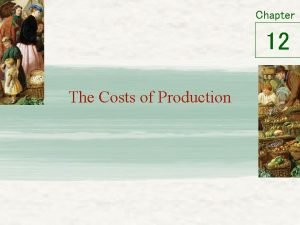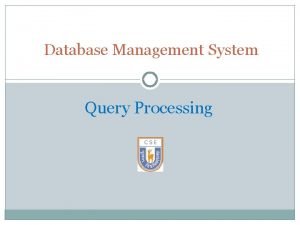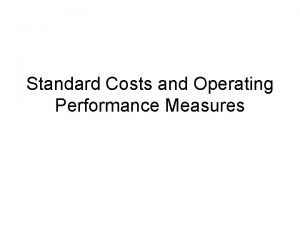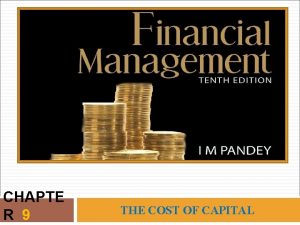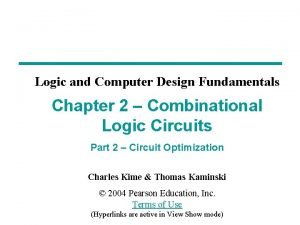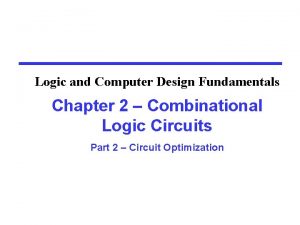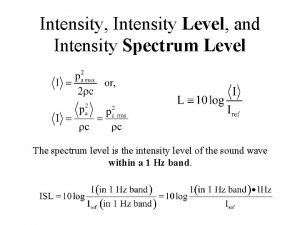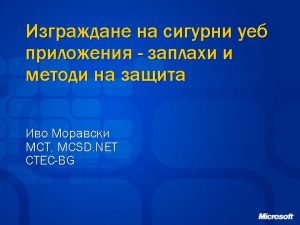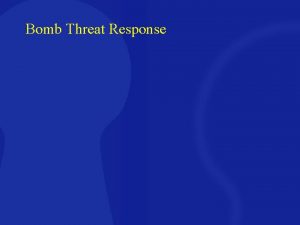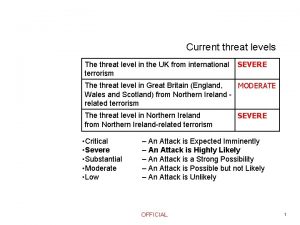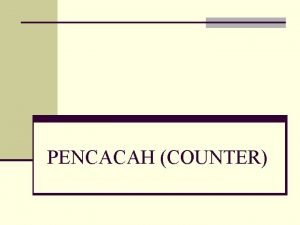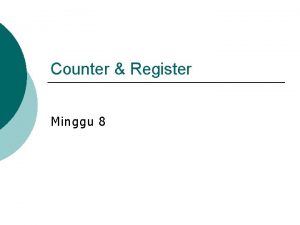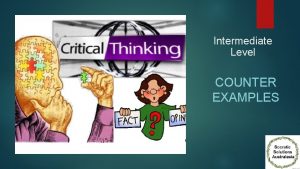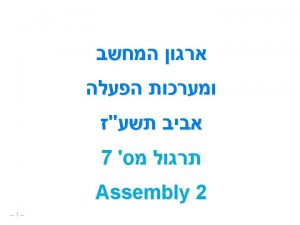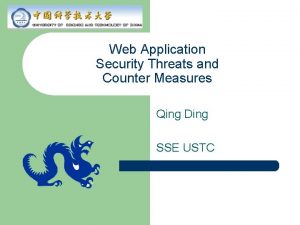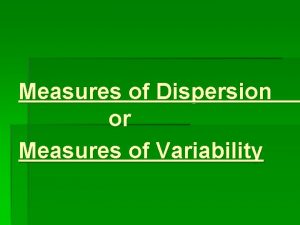Threats counter measures Threat intensity cost of counter


















- Slides: 18

Threats & counter - measures Threat intensity & cost of counter measures t 2 t 1 New type of threat Threat 1 Perception of threat 1 and counter measures y 0 y 1 y 2 Inadequacy gap yn time This means that cost of counter measures increase relatively to decrease of threat intensity. In other words in yn the counter measures system and hardware is backward orientated towards the point y 0 / t 2. Question: Are counter measures and hardware which are conceived for threat 1 adequate for new type of threat. (flexibility of hardware and responsivness of systems? ? ? )

VARNA CONFERENCE 28 - 30 /V/2008 DEFENCE R&D INDUSTRIAL & FINANCIAL APPROACH TO R&D countries SEE: PROF. IVO PAPARELA Ph. D University of Dubrovnik

• THEORIA SINE PRAXIS, SICUT ROTA SINE AXIS !!!!! PRAXIS SINE THEORIA, SICUT ROTA SINE VIA !!!!!! OLD CANNONIST DICTUM

What do we talk about ? • Costs, risks & financing of R&D • National & International political, industrial , financial framework

why do new NATO partners need R&D for better quality of defense hardware? • Because of paucity of assets &budgetary Budget line: financial resources Asset y combination of “x” &”y” Space dimension : TV &TVD: assets+men/sq km & $/sqkm of tv&tvd Countries with “big” budget & abundant assets e. g. B 1/uor: f 1 Decrease of 5 airplanes Croatia & like Asset x Slovenia/Italy: a solution ? ?

Industrial sector & market • “political economy” • SME are dominant in the SEE which are short of capital & can hardly finance r&d • NEEDS + PURCHASSING POWER= CONSUMER • CONSUMER +PRODUCT/SERVICE=MARKET • Market characteristics : supply oligopol ; demand monopson • NEEDS – PUCHASSING POWER= PROBLEMS

Comprehensive approach to DIS & DIB Present strategic thinking & policy Evaluation of various threats International framework Decision making & choice of present & future threats (probalistic evaluation) In depth analysis & ranking of choosen threats Policies of counter measurs (reactive and proactive) goals, means, man power, etc Existing DIB (works, products technology and knowledge inventory, financial capacity Markets needs purchasing power (state budgets, “diamonds”) & products Investment capacity (both publican private and policies Evaluation of policies & valuation of assets Control R&D of future Needs, products, Quality, technology Price, intelectual property etc.

International industrial integration of national DIB Degree of International integration Minority control & investment Øminority shareholder in domestic company Øjoint ventures Øfunding research Comercial relations without direct investment: Øsubcontractors Ølicence Øetc Investment & majority control Øfully owned company Øfull control of company Øetc Control of foreign market without foreign investments: Ødirect export Øtechnical assistance Øvarious management contracts Øpolitical issues Degree of control Acess to know how & control of R&D.

ALL INVESTSTORS ASK FOR EVALUATIONS /AUDIT OF ENTERPRISE & OF LABORATORY

AUDIT & VALUATION OF KEY ELEMENTS(a) • PRODUCTIVE CAPACITY: TECHNICAL &FINANCIAL VALUATION OF ASSETS( cost of replacement) • Qualitative evaluation of management & organization( cost of reconstitution) • Evaluation of corporate flexibility ( can it produce other products or more of existing / idle capacity) • Financial strength (cash flow, sharehoders, …

Audit & Valuation of key elements (b) • Market (s)( cost of penetration ab initio) • Technical quality of products ( life of product) : life cycle capability • Customers ( now under EU monitoring if military or dual use) • Price • Competitors ( products , financial strength, back-ups, etc • Margins ( benefits/ Turnover)

Audit &Valuation of key elements (c) • Intangible assets: • Evaluation scientific & technique of assets • Technical competence & stock of knowledge • Patents & trademarks : capacity to “find” • Costs of R&D/Turnover

Evaluation of a laboratory or R&D activity • This is a sequence of : a) Fundamental research “Y 1 years ”: “ 1 ” costs /year, with law probability of success : but if success than: b) Laboratory unit & tests “Y 2 years ” : “X 2$” cost/year : success probability 70% if ok than : c) Prototype industrial : “y 3”: ”x 3”cost: year; probability of success 80%; if ok than UNDER CONDITIONS specified later on d) Industrial production with market logic can be envisaged X$

Specificity of research activities • It works on conditionality (“ifs”) and future information (presently unknown) • discounted cash flow method is inadequate to valuate “ifs” (it works on statistical mean& variance which discounts expected cash flows) • Discount rate ? ? ?

Case : Research & industry • Point a) fundamental research subsidies or corporate costs or combination of both: if ok than • Point b) laboratory prototype “y 2” = four years; costs “x 2”=1 mil/y in monetary terms; if prob =0. 7; than cost =1/. 7=1. 42 mill/y; if ok than • Point c) real prototype industry involved “y 3”=Three years ; “x 3”=5 mill/y; if prob=. 8 ; than costs=5/. 8=6. 25/y : if ok than • will industry “buy” and under which conditions ? ? ?

Case: Reasearch & industry • industry looks at government ( free lunch) will government inject financial resources or will outside world inject resources e. g. EU defense agency & its budget ? ? ? • What do AF want ( national security requirements & Alliance requirements : possibility of collision of interests( eg air forces ) or governmental incompetence ( subs in Croatia ) • ETC • ONLY THAN back to the’ industrial investment analysis : discount rate!!, cash-flow , pay-back,

Obstacles on the road from discovery to industrial production in new Nato members • Downsizing of AF • Industrial capacities of the “West” can provode military hardware • Western enterprises are backed by financial institutions & “big” budgets • Industrial know-how in the new nato members are limited ( eg croatia submarines)

INDUSTRIAL PRODUCTION ? • R&D included into investments calculation(s) ? ? “ working capital “ • Customer requirements : AOC, recurrent costs , non recurrent costs • LCC • export
 Repeated measures design
Repeated measures design The various measures of cost
The various measures of cost Steps in query processing
Steps in query processing Standard cost and operating performance measures
Standard cost and operating performance measures Book value of debt
Book value of debt Cost control and cost reduction project report
Cost control and cost reduction project report Manufacturing cost vs non manufacturing cost
Manufacturing cost vs non manufacturing cost Distinguish between average cost and marginal cost
Distinguish between average cost and marginal cost Cost pools
Cost pools Literal cost gate input cost
Literal cost gate input cost Dennis geyer
Dennis geyer Cost accumulation and cost assignment
Cost accumulation and cost assignment Cost control and cost reduction project report
Cost control and cost reduction project report Process costing definition
Process costing definition Cost control and cost reduction difference
Cost control and cost reduction difference Manufacturing cost vs non manufacturing cost
Manufacturing cost vs non manufacturing cost Cost accumulation and cost assignment
Cost accumulation and cost assignment Literal cost gate input cost
Literal cost gate input cost Disadvantages of standard costing system
Disadvantages of standard costing system

